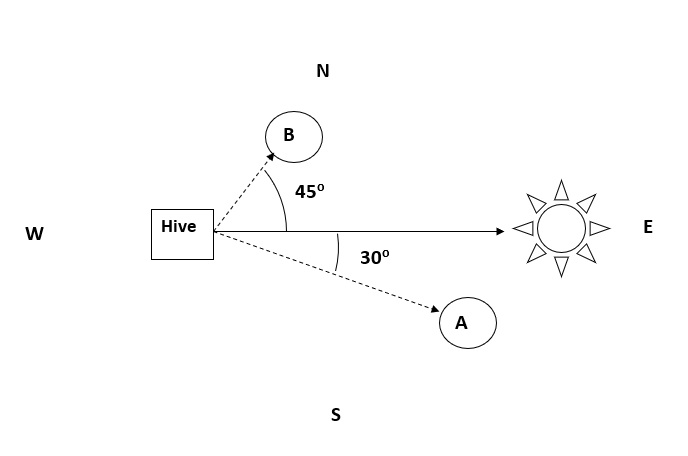Honey bee workers from a colony in North Carolina are visiting two food sites, A and B, at 6 am as shown below. Site A is 1500 m from the hive; site B is 300 m from the hive. Which of the following statements is true regarding the genetic basis of the bees’ ability to track the passage of time and compensate for the movement of the sun? a. The bees’ clock mechanism is based on the Amfor gene, which causes a build up of AMFOR protein in the corpora pedunculata that activates the Gp9 and UU genes, whose products degrade AMFOR in a 24 hour cycle. b. The bees’ clock mechanism is based on the per gene in the optic lobes, whose activity has a 24 hour cycle regulated by the dbt and tim genes. c. The bees’ clock mechanism is based on alternating expression of two alleles for the for gene in the subesophagael ganglion: the R allele which is active at night and the s allele which is active during the day. d. The bees’ clock mechanism is based on levels of eclosion hormone released from the pars interecerebralis, which increases in response to the dbt gene and decreases in response to the tim gene in a 24 hour cycle
Honey bee workers from a colony in North Carolina are visiting two food sites, A and B, at 6 am as shown below. Site A is 1500 m from the hive; site B is 300 m from the hive. Which of the following statements is true regarding the genetic basis of the bees’ ability to track the passage of time and compensate for the movement of the sun? a. The bees’ clock mechanism is based on the Amfor gene, which causes a build up of AMFOR protein in the corpora pedunculata that activates the Gp9 and UU genes, whose products degrade AMFOR in a 24 hour cycle. b. The bees’ clock mechanism is based on the per gene in the optic lobes, whose activity has a 24 hour cycle regulated by the dbt and tim genes. c. The bees’ clock mechanism is based on alternating expression of two alleles for the for gene in the subesophagael ganglion: the R allele which is active at night and the s allele which is active during the day. d. The bees’ clock mechanism is based on levels of eclosion hormone released from the pars interecerebralis, which increases in response to the dbt gene and decreases in response to the tim gene in a 24 hour cycle
Medical Terminology for Health Professions, Spiral bound Version (MindTap Course List)
8th Edition
ISBN:9781305634350
Author:Ann Ehrlich, Carol L. Schroeder, Laura Ehrlich, Katrina A. Schroeder
Publisher:Ann Ehrlich, Carol L. Schroeder, Laura Ehrlich, Katrina A. Schroeder
Chapter6: The Lymphatic And Immune Systems
Section: Chapter Questions
Problem 91LE: tonsils and _____________________________
Related questions
Question
Honey bee workers from a colony in North Carolina are visiting two food sites, A and B, at 6 am as shown below. Site A is 1500 m from the hive; site B is 300 m from the hive.
Which of the following statements is true regarding the genetic basis of the bees’ ability to track the passage of time and compensate for the movement of the sun?
a. The bees’ clock mechanism is based on the Amfor gene, which causes a build up of AMFOR protein in the corpora pedunculata that activates the Gp9 and UU genes, whose products degrade AMFOR in a 24 hour cycle.
b. The bees’ clock mechanism is based on the per gene in the optic lobes, whose activity has a 24 hour cycle regulated by the dbt and tim genes.
c. The bees’ clock mechanism is based on alternating expression of two alleles for the for gene in the subesophagael ganglion: the R allele which is active at night and the s allele which is active during the day.
d. The bees’ clock mechanism is based on levels of eclosion hormone released from the pars interecerebralis, which increases in response to the dbt gene and decreases in response to the tim gene in a 24 hour cycle

Transcribed Image Text:W
Hive
B
N
45°
S
30⁰
A
E
Expert Solution
This question has been solved!
Explore an expertly crafted, step-by-step solution for a thorough understanding of key concepts.
Step by step
Solved in 3 steps

Knowledge Booster
Learn more about
Need a deep-dive on the concept behind this application? Look no further. Learn more about this topic, biology and related others by exploring similar questions and additional content below.Recommended textbooks for you

Medical Terminology for Health Professions, Spira…
Health & Nutrition
ISBN:
9781305634350
Author:
Ann Ehrlich, Carol L. Schroeder, Laura Ehrlich, Katrina A. Schroeder
Publisher:
Cengage Learning

Essentials of Pharmacology for Health Professions
Nursing
ISBN:
9781305441620
Author:
WOODROW
Publisher:
Cengage

Medical Terminology for Health Professions, Spira…
Health & Nutrition
ISBN:
9781305634350
Author:
Ann Ehrlich, Carol L. Schroeder, Laura Ehrlich, Katrina A. Schroeder
Publisher:
Cengage Learning

Essentials of Pharmacology for Health Professions
Nursing
ISBN:
9781305441620
Author:
WOODROW
Publisher:
Cengage